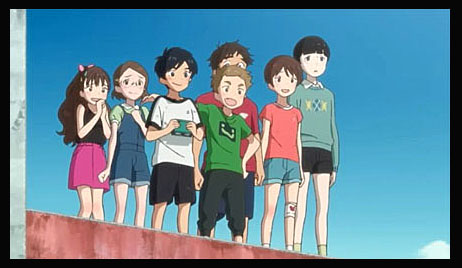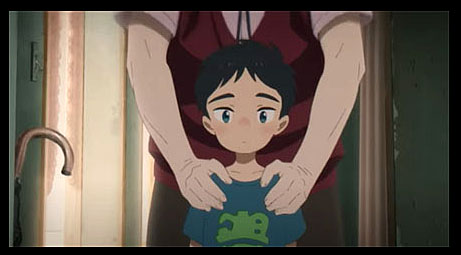
Drifting Home is a new anime feature that beautifully blends multiple genres and tones. It’s about a group of kids on a one of a kind journey in an old apartment building floating in the ocean. Drifting Home is currently playing exclusively at Landmark’s Piedmont Theatre in Oakland, CA for an awards qualifying run. It will stream on Netflix starting this Friday September 16th. Director Hiroyasu Ishida and producer Hibiki Saito join me for this Animation Scoop Q&A. (This interview contains mild story spoilers, was conducted over Zoom with a translator, and was edited for length and clarity.)
Jackson Murphy: Hiroyasu, the kids in this film feel so real and relatable. What was your process of coming up with them and having them carry this movie?
Hiroyasu Ishida: We wanted to tell a story with grade school kids here. So it really began with them. We had our two main protagonists Kosuke and Natsume cemented from the get-go. After that it was a process of trying to surround these two with a bunch of colorful characters who each had their own distinct characteristics. For example, we have Reina, the girl who’s always very aggressive and fighting with someone. Very prickly. We have a boy named Taishi who’s always in your field of sight and running about. These are kids who maybe remind you of someone who was in your class or school — very familiar characters in a way. It was a matter of attaching certain, very atypical characteristics. It was a matter of putting names onto those characters. It was a process of me writing and drawing the storyboards and arriving at the certain characters who I thought, “Okay, this might be interesting to bring into the film.”

JM: And Hibiki, this is one of the most visually ambitious anime films I’ve ever seen.
Hibiki Saito: This film all started with a single sketch that our director showed us — this apartment building that was drifting… adrift along the sea. It was so impactful when I saw it. I thought, “We can definitely make a movie out of this. Let’s go with this.”
JM: Wow. And Hiroyasu, why was it important for you to have one of the main themes of the film be regret?
HI: I suppose you’re talking about the character of Kosuke, and what I wanted to depict was this: whenever a person has to do something, you need this kind of energy for forward propulsion. Something needs to make you do something. That motivation springs from a sense of failure. We all have to go through failure, and we all go through a learning process through that failure. And I think it’s only through those stages that we can finally come to a way of redemption or to a means of making up or atoning for the wrongdoings (or non-doings of what we’ve done).
JM: Very powerful theme. Hibiki, can you talk a little bit about how this movie is able to balance so many emotions through the characters?
HS: This is not our first collaboration. We previously worked on Penguin Highway, another story about children. Not as many children as you see in this one. But you can also see that the characters in that film… individually are very distinct and the way that they interact with each other is very comical. Watching that, I realized I knew how wonderful and able and capable our director was at depicting kids. This time around, we have seven kids. I was very confident that our director would be able to depict each and every kid in a very attractive way.

JM: Yes. Absolutely. Hiroyasu, what were the challenges in how you wanted to present the character of Noppo? Such great spirit and presence.
HI: This character is not a boy, but a spirit. In depicting a non-human being, we had to be careful with how we bring forth his expressions and his emotions. We wanted to draw a distinct difference between the other kids who are alive. We wanted a very mysterious character. He doesn’t have a lot of dialogue. His eyes are not very wide open or as vivacious as the other kids’ eyes are. But then he goes through this certain character arc. He comes to terms with the role he has shouldered in this world… his own destiny. Along that character arc, we did tweak the expressions. And throughout his relationship with Kosuke and Natsume, we see a very human emotion erupting and this sense of lingering affection towards these kids. We were very careful and meticulous about that emotional transition in this character.
JM: I love Noppo. And Hibiki, how do you feel about this being on Netflix for the world to see — and for Netflix and anime to really come together to present Drifting Home to everyone?
HS: Up until now, the Japanese animation scene and industry was kind of very closed. In turning out works, everybody was pretty much concentrated only on the domestic Japanese market. We’ve also had this sense of distance — not only geographic but psychological distance between Japan and other nations. Whenever a Japanese animated work was delivered overseas, there was a time gap in localization. That kind of made way for a certain kind of psychological and emotional distance between us and the international market / audience. But now finally with Netflix we are able to bring it almost at the same time, not only to our Japanese audiences but the entire world. We have a sense that that psychological distance is shrinking, and it brings me a sense of excitement and anticipation to see that the animation industry is not going to be the same going forward.
- INTERVIEW: Jeff Fowler On “Knuckles” And “Sonic 3” - April 22, 2024
- INTERVIEW: “Inside Out 2” Director And Producer On Pixar Sequel - April 16, 2024
- INTERVIEW: “Puffin Rock And The New Friends” And 25 Years Of Cartoon Saloon - April 10, 2024


 September 12th, 2022
September 12th, 2022  Jackson Murphy
Jackson Murphy  Posted in
Posted in  Tags:
Tags: 






